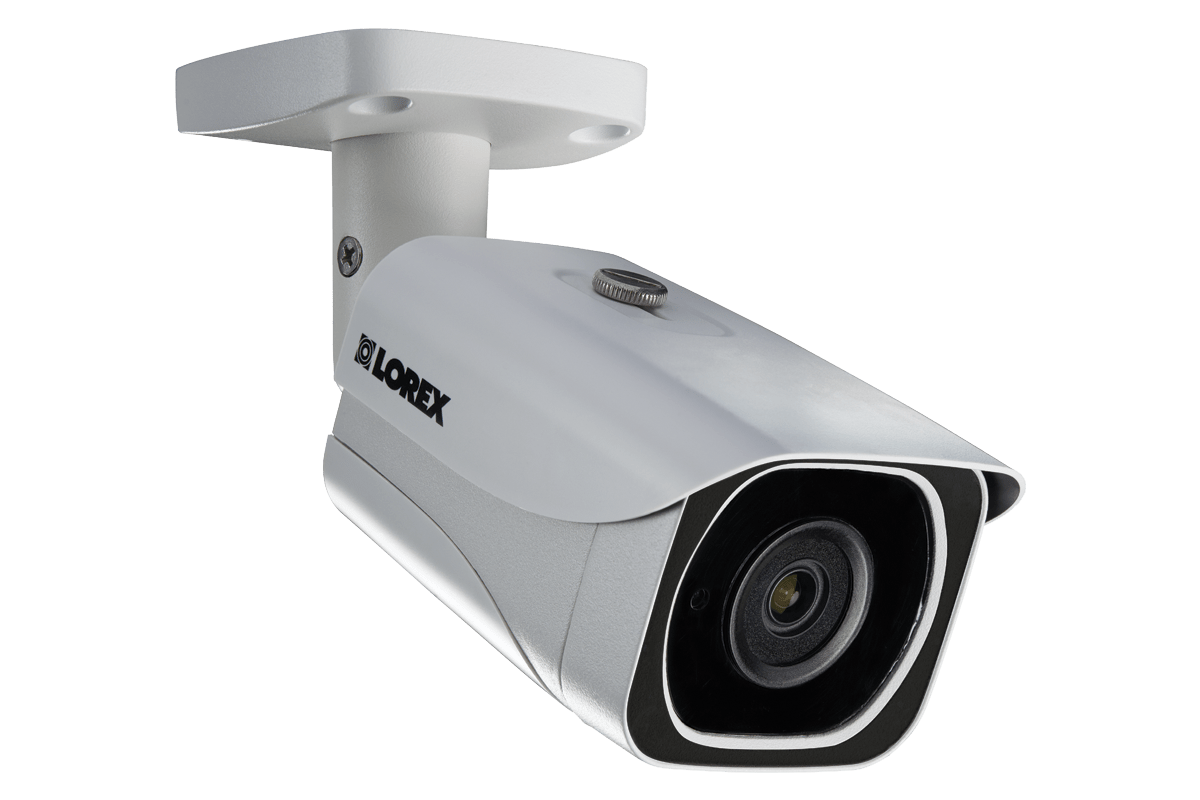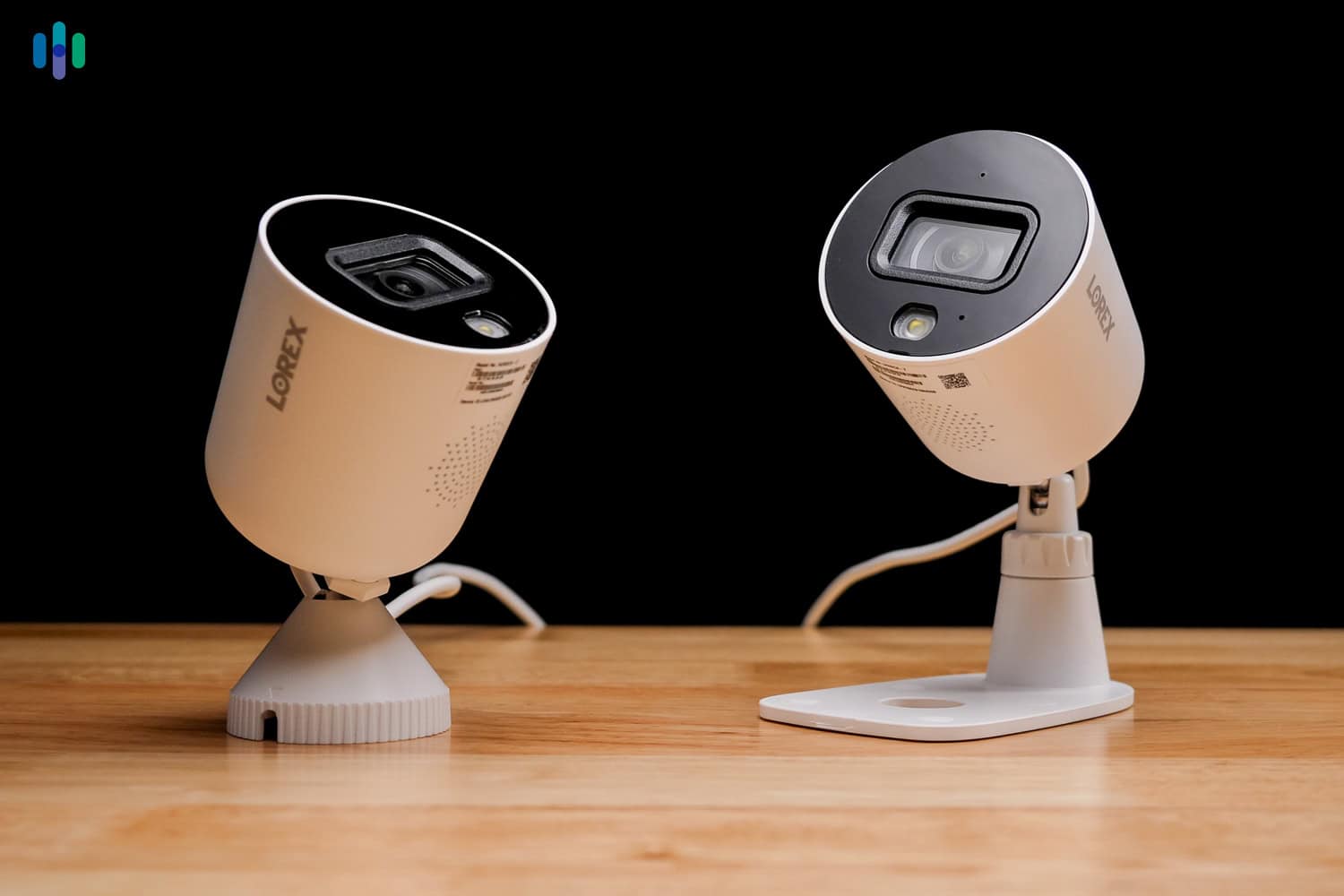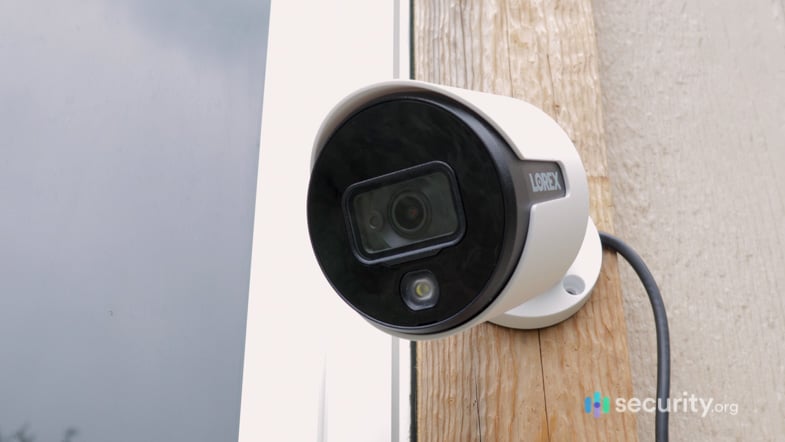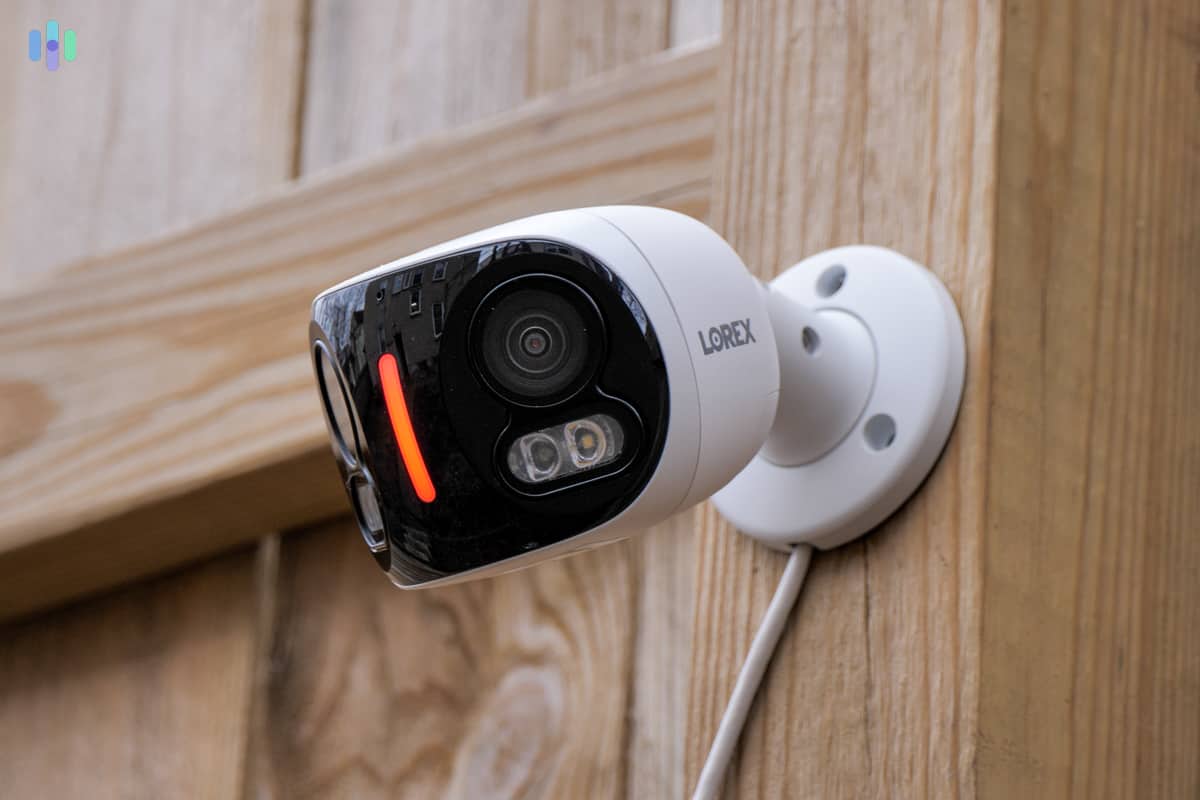Lorex Security Camera Review
With continuous recording and no required monthly fees, Lorex is great for homeowners and businesses that want always-on, always-recording security cameras.
 Aliza Vigderman, Senior Editor, Industry Analyst
&
Aliza Vigderman, Senior Editor, Industry Analyst
&
 Gabe Turner, Chief Editor
Last Updated on Mar 06, 2025
Gabe Turner, Chief Editor
Last Updated on Mar 06, 2025
What We Like
- No Required Monthly Fees: Lorex cameras record locally using DVRs and NVRs, which means cloud subscriptions are optional.
- High Video Quality: Lorex offers a wide range of cameras, some of which have a 2K or 4K resolution.
- People and Vehicle Detection: Artificial intelligence improves the motion detection of Lorex cameras, allowing them to reliably detect people and vehicles, while ignoring other moving objects.
What We Don't Like
- Installation: The installation process is left entirely to the user, and the way the cameras are setup often requires running cables throughout the house.
- No Professional Monitoring: Due to privacy concerns, Lorex leaves the monitoring to the user. That means if the cameras detect motion, it’s up to the user to check and verify the alert and also call for help if necessary.
- Customer Service: While Lorex does offer support to customers, it’s available only on Mondays through Saturdays between 11:00 am and 10:00 pm EST.
Bottom Line
Lorex makes good, solid cameras. Period. With video resolutions ranging from 1080p to 4K HD, superb night vision, and on-location video storage through DVRs and NVRs, you’ll enjoy professional-grade home security equipment without the high monthly fees.Lorex is one of the few companies that doesn’t require a subscription for its security cameras. You can choose to record them locally instead of uploading footage to the cloud. However, there are some trade-offs to consider.
For starters, you’re responsible for installing the cameras, and some of them require cables to run throughout the house. There’s also no professional monitoring and no other home security equipment besides security and doorbell cameras. After testing Lorex for six months, we still think it makes some of the best security cameras on the market. Let’s go through our experience and see why they’re on our list.
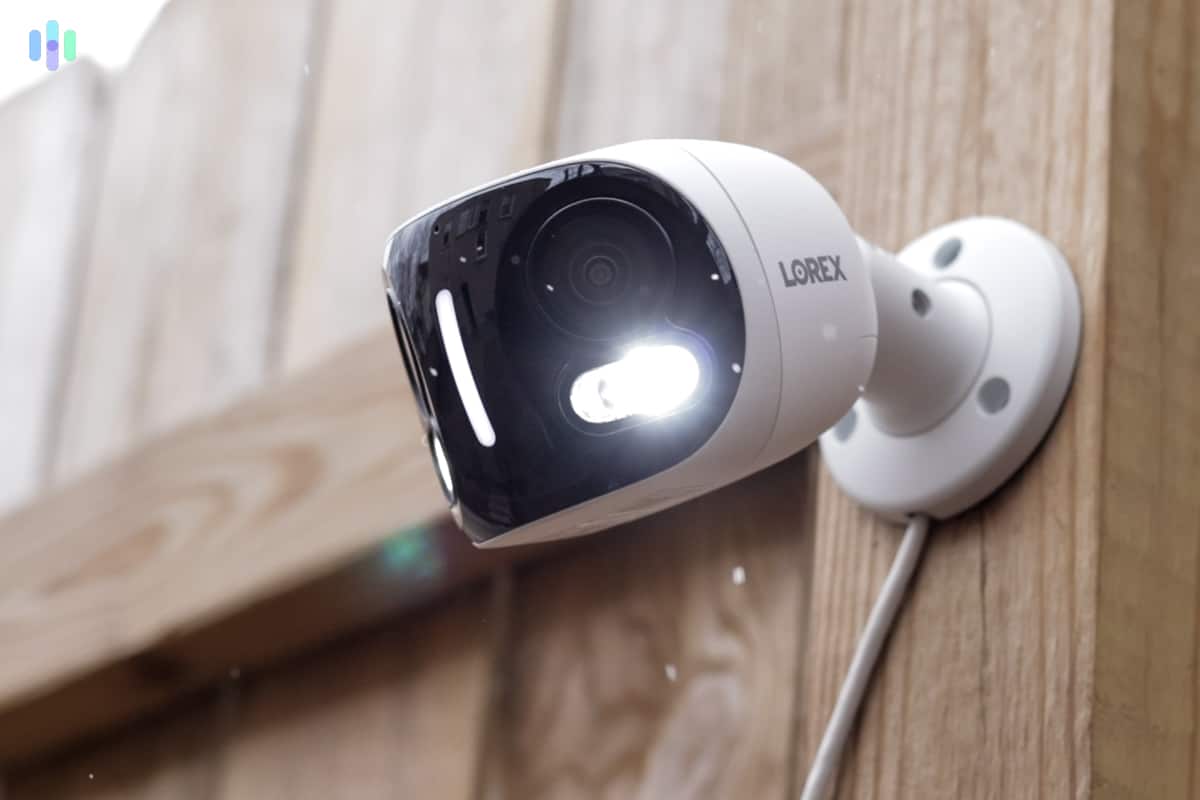
Pro Tip: With stunning video quality, see how our #1 pick SimpliSafe Outdoor Camera is a better alternative to Lorex.
Overall Rating
- Exceptional video quality up to 4K
- Commercial-grade quality and construction
- Several custom recording options
Our Video Review
The video review below is a fun way to get into the capabilities of the Lorex cameras that we tested, but it’s also quite instructional. We could type out all kinds of fancy words to describe the 4K resolution and night vision on the camera we tested, but actually seeing the video will give you a much better idea. Check out the video and see what we saw through the lens of our Lorex camera.
Speaking of 4K video, it looks great on your screen but this level of resolution is more demanding than regular old HD video. It requires a lot more bandwidth to stream and a lot more space to store. A general rule of thumb is that you need speeds of at least 25 Mbps to stream 4K video, and about 40 GBs to store an hour of it. By comparison, you only need 5 Mbps to stream 1080p video and one hour of it takes up around 1.5 GB. Bottom line: If you don’t have the speed or storage space to handle 4K, you’ll need to upgrade those aspects of your home network.
If you don’t want to make those upgrades, Lorex does have camera options with lower resolutions. In the video below, we tested a Lorex camera with 2K resolution. Click on the video and you’ll see that it is very high quality, and we didn’t have to completely overhaul our home network.
The Beginning of Our Process
We always base our recommendations on first-hand experience, so as you can see in our video reviews, our experts took home Lorex cameras to test. The buying part is usually easy. We research and pick several of the best cameras from the brand, and then whip out our credit card to purchase those. That was the case when we chose to review the Nest Cam (battery) from the Nest Cam lineup.
Lorex has such a wide range of options, including professional grade cameras, that we had to switch it up a bit for this review. Instead of picking out the best cameras and putting them through their paces, we selected cameras we thought were best for the typical home user. With that out of the way, let’s take a look at the system we put together.
>> Check Out: The Ultimate Guide to Home Security Cameras
Choosing Our Lorex System
We had our mind set on testing Lorex’s DVR systems because we wanted to get a feel for these always-on, always-recording cameras Lorex offers. Most of the cameras we test, like the Ring Spotlight Cam we reviewed recently, are configured to record only when there’s motion, so Lorex offers a really nice change of scenery.
Filtering Lorex’s catalog to that of only DVR systems did the trick. It narrowed our options down to about a dozen systems. We went through each system and found one offering cameras that would let us test Lorex’s full capability in terms of camera resolution, smart home integrations, advanced detection, and so on. It was none other than the Lorex 4K Ultra HD system that comes with an eight-channel DVR, which by the way is one of the pricier systems in Lorex’s catalog. It contained:
- A One TB Hard Drive
- Four 4K Cameras
- Four 60 Foot BNC Cables
- Four Mounting Kits
- Five Power Adapters
- One Ethernet Cable
- One HDMI Cable
- One Mouse
- One Security Decal
- One Quick Start Guide.
We unboxed and tested it out, and here’s what we thought of the system’s features.
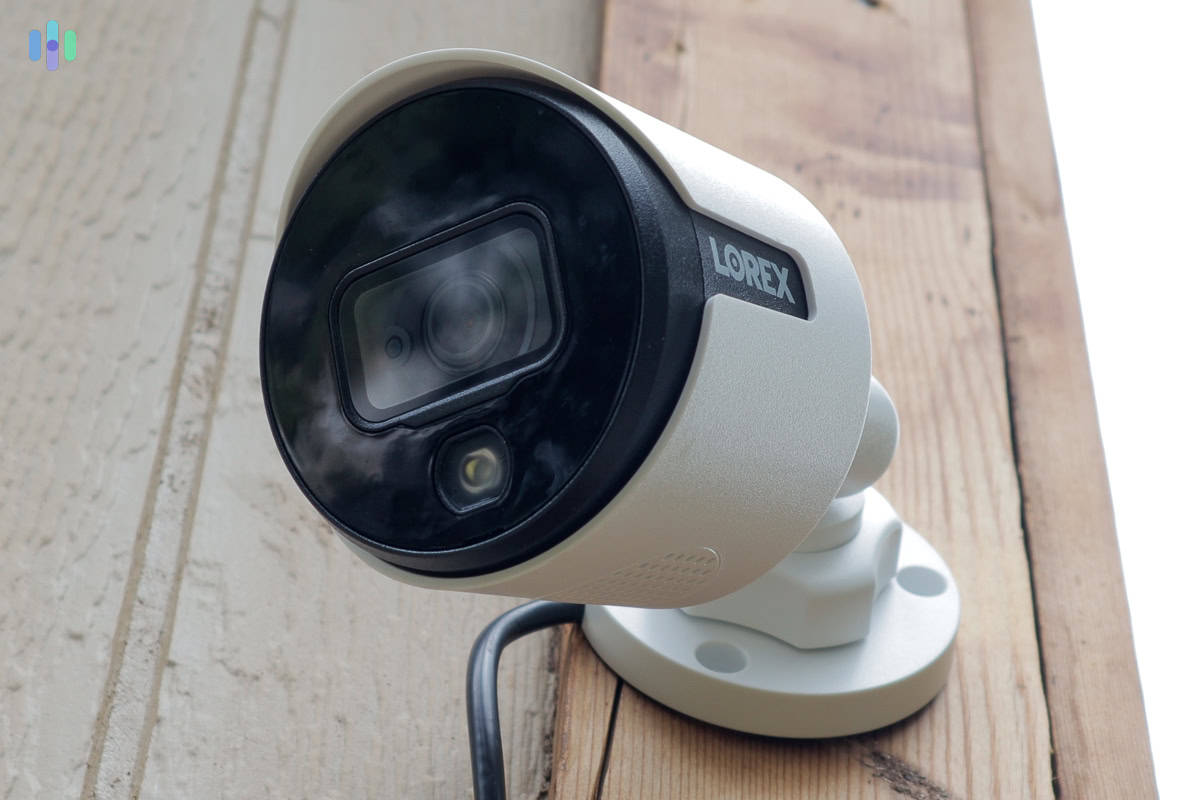
Storage With The One TB Hard Drive
In addition to avoiding monthly fees, local recording via a DVR or NVR also means lower risk of hacking. With both local and cloud storage, which is available on some Lorex systems, you have an automatic video backup in the cloud.
Pro Tip: While hacking security camera cloud storage isn’t rare, most cases can be attributed to poor password habits. Some users don’t change the default password of their security cameras, which enables hackers to access their cameras and storage without much difficulty.
However, we found that Lorex’s DVR setup wasn’t without downsides, with the biggest one being limited storage. The typical 1 TB Lorex DVR can store about 20 days of recordings from one camera, but our four cameras filled the hard drive after five days. That meant we had to back up important clips after five days to keep them from getting overwritten, or upgrade to more storage. This increases the costs, so keep that in mind when reviewing Lorex’s pricing.
4K Video
4K video is all the hype these days, and Lorex is riding the wave. Right now, Lorex has the largest catalog of 4K security cameras. The good news is they are some of the best 4K cameras you can buy.
Before you go all in on 4K cameras though, ask yourself if it’s worth the hype. We asked our in-house video expert what he thought, and he said that 4K cameras can be a double-edged sword.
On one hand, they have clear video quality. From a security perspective, that means if your house is burglarized, you’d be able to see more and clearer details of the crime. You might even be able to zoom in and look at the perp’s face or read the license plate of their getaway car. The Lorex cameras we tested could zoom in up 25 times, confirming our expert’s opinion.
On the other hand, though, he said that 4K security cameras consume Wi-Fi like crazy. It’s one if you have one or two 4K cameras – most Wi-Fi networks can handle it – but any more than that could spell trouble for your network. That’s specially true for the always on, always recording Lorex cameras. And speaking of recording, videos from 4K cameras take up more space than 1080p videos.
Our recommendations? Use 4K cameras to cover large spaces, like your front and back yards. Use 2K or 1080p cameras to cover indoor and smaller outdoor spaces. At this point, there’s no need to go with 720p cameras. Those offer a significant drop-off in picture quality and they don’t offer much savings.
Hardware Specs and Design
One key aspect of Lorex cameras is their ruggedness. The outdoor cameras we tested can work in temperatures between -40 and 131 degrees Fahrenheit. They were also weatherproof and tamper-resistant.
But that hardiness of Lorex cameras often comes at the cost of the design. Most Lorex cameras are bulky and heavy; think street corner or storefront cameras. They don’t exactly fit in that well in a residential setup.
Lorex is making improvements in this department. The company recently released cameras with a sleeker design that reminded us of Arlo and Nest. They’re still bulky, but features like color-changing ring lights on the lens are easier on the eyes.
Read More: The Best Outdoor Security Cameras of 2025
Additional Features
Security cameras are becoming more advanced. Nest Cams integrated into ADT security systems use facial recognition to identify regular visitors and unlock smart locks to let them in. Lorex cameras aren’t there yet, but they have a few tricks of their own, such as:
- Smart Home Integration: Our security system was compatible with both Alexa and Google Assistant. This meant we could access our security system with voice control using our smart speakers and displays. And yes, that extends to Android smart TVs as well as TVs with Chromecast, via the Lorex Secure App. Lorex also works on Apple TVs. So besides directly hooking up your DVR to your TV (which takes up an HDMI slot), you can make integrations happen wirelessly – provided that you have a good internet connection.
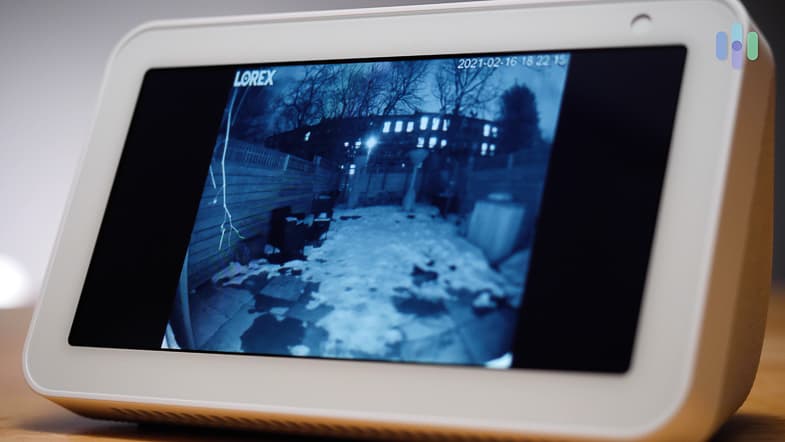
- Night Vision: In our opinion, Lorex offers the best night vision cameras. The outdoor cameras have color night vision and a range of up to 200 feet in complete darkness, though some ambient light is needed. If it’s too dark, infrared night vision kicks in with visibility up to 120 feet, which is still impressive.
FYI: Other security cameras, like the SimpliSafe Outdoor Camera Pro from our SimpliSafe review, offer color night vision using a bright spotlight. While outdoor lighting provides added security, some homeowners prefer their cameras hidden. If that’s the case, Lorex’s color night vision is a great option.
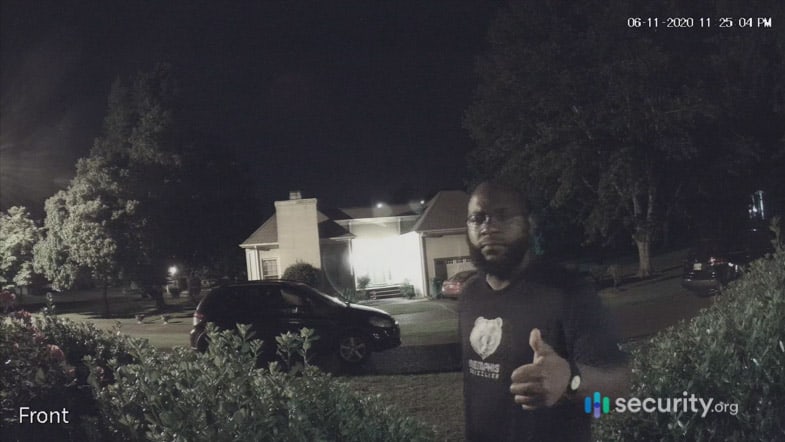
- Storage: We stored videos on the recorder, which gave us about 5 days to a week of rolling video history, but we liked having cloud backup as well. Now, that’s one thing you should consider before choosing Lorex, because not all Lorex cameras work with cloud storage. Fortunately, the ones that do have access to affordable cloud backup – $2.99 per month or $29.99 per year for one camera or $9.99 per month or $50 per year for multiple cameras, 30 days of event recording from unlimited cameras. That’s affordable; when we looked at Arlo’s pricing, cloud storage for unlimited cameras cost $19.99 per month. Granted, we saw more advanced features when we reviewed Arlo, but Lorex is more affordable.
- Motion Detection: Lorex offered something called RapidRecap, an easy way to locate motion from the camera. Essentially, this was our event history compiled into a quick and easy time-stamped video. The fact Lorex provided RapidRecap made it incredibly easy to sift through cloud history and saved us a ton of time when we were looking for specific movement within videos, like one time when a friend from out of town arrived on our doorstep unexpectedly.
Installing Our System
Installing Lorex cameras can be complicated if you’re unfamiliar with wired setups. Most of the systems are built around a DVR (digital video recorder) or NVR (network video recorder). These devices require a Wi-Fi or Ethernet connection to work. Once installed, they process videos from the cameras and store them in the built-in hard drive.
While we love the local storage, setting up a DVR or NVR adds a few steps to the installation process. We recommend starting by clearing out some space for the DVR or NVR, as they aren’t exactly small. They are about the size of a DVD player, and again, they need to sit close enough to the router.
Setting up the recorder is easy, though. In most cases, you just have to plug it in, connect it to your router, and then boot it up. That’s the case with the DVR we received, and it started up nice and smooth.
Next, we had to place the cameras and then connect them to the DVR. The latter was the tough part. All four cameras we received were indoor/outdoor types, but we decided to keep them all outdoors. After all, they looked too bulky for our interior design.
Each camera needs two types of wires: The first one is for power, which plugs into a wall outlet; the second one goes to the DVR for data transfer. We had to get creative, which meant drilling, snaking wires through the ceiling, and using an all-important tool of the trade to keep the wires out of our way: duct tape.
That said, not all Lorex cameras are as time-consuming to install as the one we had purchased. There are wire-free Lorex cameras that run on batteries and connect to Wi-Fi, so basically, all you’ll have to do is mount them. There are also cameras that do plug into a wall outlet but use Wi-Fi to transmit video and audio. Those cameras are called Wire-free and Wireless cameras, so check them out if they are more your style.
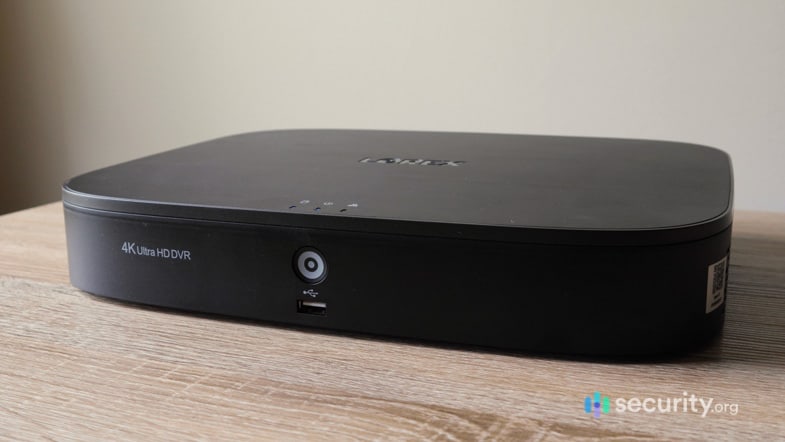
Eventually, we got things done but after installing the cameras and the DVR, we still had questions about how to connect our system to the app. That was when we decided to call customer support. We also had the option of live chatting with a customer service rep on the Lorex website, but we felt that would be more time consuming. We were hopeful our representative would answer our questions, but honestly, we didn’t get the kind of service we expected. The representative we spoke with was a bit short and didn’t seem interested in helping. He did eventually help us set our system up, but it wasn’t the most professional experience we’ve ever had.
The Lorex Secure App
Because our Lorex system was self-monitored, having a decent app was key, since that’s where we viewed our livestream and received notifications. The Lorex app worked on all devices, which was great because we used both Apple and Android products in our household. Once we downloaded the app, we got push notifications, saw both live and recorded video and grouped cameras together. For example, we grouped together our outdoor front cameras and outdoor back cameras which made it possible to livestream multiple cameras at one time. This made the self-monitoring portion simple when live streaming because we had eyes on multiple places simultaneously.
You Should Know: The mere presence of security cameras could deter an intruder, so install the cameras in a visible location.
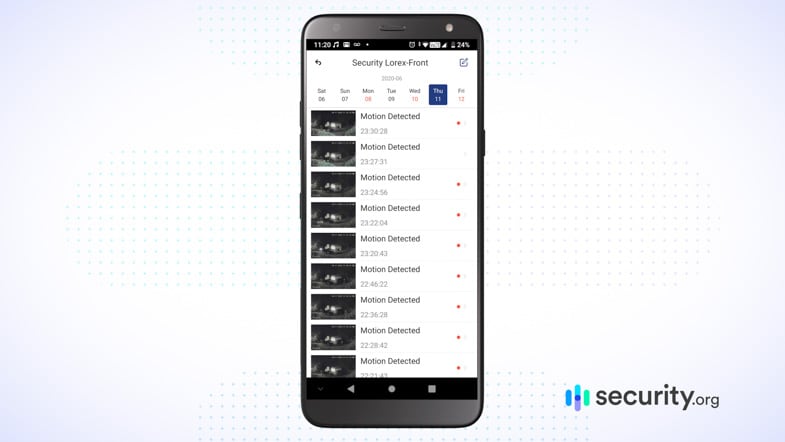
Lorex Pricing
We’ve all heard the saying “you get what you pay for” and that’s the case with Lorex. Because of the wide variety of systems, there are a wide variety of prices. Our system was on sale for $387.99 but normally costs $699.99.
Pro Tip: Take advantage of Lorex’s open box deals, which are gently used security systems at a discounted price with a one-year warranty.
One of our favorite things about Lorex was there was no mandatory monthly fee. While the initial investment may feel like shelling out a large chunk of change at one time, many other security companies require long-term contracts and monthly fees even after the initial equipment costs. Some don’t even store footage unless you pay for a cloud subscription. The Ring cameras we reviewed, for example, require a $10 monthly fee to store videos from the entire camera system. But not Lorex; once we paid for the product we were done. Of course, that wouldn’t be the case if we sprung for the unlimited cloud storage.
Lorex vs. Other Brands
Compared to most security camera brands we test, Lorex is kind of unique. Take Ring, for instance. This Amazon-owned security camera brand offers mostly wireless security cameras that store videos in the cloud. And without local storage, Ring cameras need a subscription to be able to record. The same goes for the Google Nest Cam family.
That said, there are still brands like Lorex that offer local recording devices, or at the very least, security cameras with a microSD card slot for local storage. Swann and Wyze come to mind, both offering affordable video monitoring solutions.
Let’s take one product from each brand and compare them to the Lorex 4K camera we tested.
| Features | Lorex H30 | Ring Spotlight Cam Wired Plus | Google Nest Cam (battery) | SimpliSafe Outdoor Security Camera | Wyze Cam Outdoor v2 |
|---|---|---|---|---|---|
| Resolution | 4K | 1080p HD | 1080p with HDR | 1080p | 1080p HD |
| Local storage | MicroSD and DVR | N/A | N/A | N/A | MicroSD card |
| Cloud storage cost | $3-$10/month | $5-$20/month | $8-$15/month | $9-$79.99 | $2.99-$3.99/month |
| Wired or wireless? | Wired | Wired (plug-in) | Wireless (battery-powered) | Wireless (battery) | Wireless (battery-powered) |
| Night vision range | 98+ ft | 30 feet | 20 feet | 30 feet | 25 feet |
| Operating temperature | -22 to 140 degrees Fahrenheit | -5 to 122 degrees Fahrenheit | -4 to 104 degrees Fahrenheit | 4 to 122 degrees Fahrenheit | -4 to 122 degrees Fahrenheit |
| IP rating | IP 67 | IP 55 | IP 54 | IP 65 | IP 65 |
| Device/system price | $199 | $169 | $179 | $199 | $63 |
Our Lorex Camera System Research and Data
The following is the data and research conducted for this review by our industry-experts. Learn More.
Encryption
| In Transit | Yes |
|---|---|
| At rest? | Yes |
| All network communications and capabilities? | Yes |
Security Updates
| Automatic, regular software/ firmware updates? | No |
|---|---|
| Product available to use during updates? | Yes |
Passwords
| Mandatory password? | Yes |
|---|---|
| Two-Factor authentication? | Yes |
| Multi-Factor authentication? | Yes |
Vulnerability Management
| Point of contact for reporting vulnerabilities? | |
|---|---|
| Bug bounty program? | No |
Privacy Policy
| Link | Privacy Policy |
|---|---|
| Specific to device? | No |
| Readable? | Yes |
| What data they log | Contact information like name, address, email address and telephone number, account information, payment information, product reviews and feedback, device ID, your Wi-Fi network, IP address, cookies, device information and web beacons. |
| What data they don’t log | Not expressly stated |
| Can you delete your data? | Yes |
| Third-party sharing policies | Yes |
Surveillance
| Log camera device/ app footage | Yes |
|---|---|
| Log microphone device/ app | Yes |
| Location tracking device/ app | Yes |
Parental Controls
| Available? | No |
|---|
Company History
| History of Breaches? | No |
|---|---|
| Action Taken? | Not applicable |
Additional Security Features
| Privacy Shutter | No |
|---|---|
| Privacy Zone | No |
Our Final Thoughts
Lorex was a good option for us. We loved the clear video and lack of lengthy contracts and monthly fees. But because there was no professional monitoring option, this system’s best for someone who lives in a gated community, an apartment with a doorman or somewhere with other security measures in place. Otherwise, you may get stuck in a situation where you’re unable to call the police for whatever reason, but for someone looking to avoid monthly fees, Lorex is a great option.
Another issue with Lorex is the sheer number of options when it comes to cameras. Most homeowners don’t need this many options, and sorting through all of them can get tedious. On the other hand, companies like SimpliSafe and Google Nest make a few versatile cameras that are suitable for most homes.
Lorex FAQs
-
Are Lorex cameras secure?
Lorex cameras are secure because all of the footage is stored locally on a hard drive rather than in cloud storage. As long as you change your administrator password periodically and create long, complicated, and unique passwords every time, your system will be secure. Also, make sure to perform all firmware updates as soon as possible.
-
Is Lorex owned by FLIR?
Lorex is currently owned by Dahua Technology Co. FLIR Systems sold Lorex to Dahua in February 2018.
-
Why did my Lorex cameras stop working?
Your Lorex cameras may have stopped working because the camera may not be connected to the power adapter. You might also have a faulty cable.
PR News Wire. (2019). Smart Home Security Market to Grow at a CAGR Of 19.6% During 2018 – 2022.
prnewswire.com/news-releases/smart-home-security-market-to-grow-at-a-cagr-of-19-6-during-2018–2022–300927558.html

